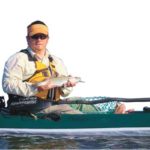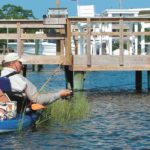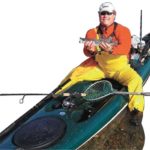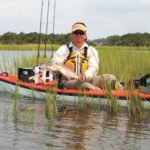
Fishing from a kayak has become a popular approach to findin’ ‘em where you usually can’t.
Gliding silently across the mirror-like surface of the water, Ernie Williams effortlessly eased around a grassy point and positioned himself near the overhang of a marsh bank.
Sheltered from a light breeze in a little section of water that wasn’t moving much, he was in perfect position to cast to a school of peanut pogies.
The school of baitfish working the little bay off the main creek had been visible for several hundred yards. They were swimming in large sweeps around the perimeter of the cove, with an occasional foray from the bank to open water.
Their fins occasionally protruding from the water, created a pattern that was difficult to mistake. We hadn’t seen anything bust on them, but the bait was moving quickly enough we were sure they were being pushed by some unseen piscatorial predator.
Williams had to wait and hold his position for a few minutes, but sure enough the school of bait finally moved into his casting range. With a short and measured backcast, he lifted a topwater lure just far enough in front of them they didn’t spook. The rings from the lure settling on the water had only radiated a few feet when the baitfish moved close, and he began to twitch the lure.
As Williams alternately walked and paused the lure across the tranquil surface, I watched hard, trying to see the lunge I knew was forthcoming. The strike didn’t come right away and the pause lulled us into allowing our attention to be diverted elsewhere.
On about the 10th cast, the lure was halfway in when the water humped up behind it and surged forward. The accompanying roll was unmistakably that of a redfish, but in somewhat typical fashion, it missed the hooks.
Quickly casting again to the center of the action, Williams began deliberately walking the dog with the torpedo-shaped lure. Following as if on cue, the redfish boiled up on the lure again.
This time it got enough of the lure to drag it under for a second or two, but again it popped up without being embedded in the fish.
Williams twitched the lure a few times before moving it, but after a couple of near misses it wasn’t tempting enough to warrant a third try, so he reeled in to cast again. This time a snafu in the line mangled the cast and he set about untangling a professional overrun (backlash). The lucky redfish had escaped — at least for now.
Later in the morning Williams found a few red drum, a trout or two, some flounder and one big croaker; all were released.
The nicest thing was fishing silently and virtually undisturbed. Except for our occasional questions and joking banter, it was so quiet we could hear the breeze rustling through the marsh grass and every time something busted on a school of baitfish down the creek or around the last bend. We were relaxed yet surprisingly alert at the same time.
This morning’s adventure had been arranged by The Adventure Company (www.theadventurecompany.net, 910-454-0607) of Southport.
Our guide was Ashley Williams (“The Druminator,” druminator228@yahoo.com) of Wilmington and Greenville. Joe Laughlin of Southport was the other fisherman, and Ernie Williams had come along to assist Ashley.
We launched early in the morning to take advantage and ride the last of the rising tide into the creeks along the upper Elizabeth River near the Oak Island Bridge.
We fished the falling tide as it flushed the shrimp and minnows out of the marshes. Our return paddle was boosted for a while by riding the falling tide back out of the creeks. It didn’t actually get tough until we reached the Intracoastal Waterway and, while the tide was pretty strong, the abundance of powerboat traffic kept us far more on edge while we crossed it.
Early in the trip, Ashley Williams led Joe Laughlin around a boat lift to a little indentation in the edge of the marsh between two docks. They eased into the indentation, which got them out of the current and began flipping their baits up under the docks.
“This is positioning you can’t get in even the smallest flats boat,” Williams said, turning to me holding out near the end of the dock. “However, with a kayak, you can paddle right around the edges of the dock and lift and cast baits to where the fish will be holding to get out of the main current.
“They’re hiding in the depths and shade under the docks or behind the pilings and waiting to see what this falling tide sweeps out of the grass.”
As if on cue, something grabbed Laughlin’s bait and surged out from under the shade of the dock. His rod was bent double with Williams coaching him and reminding him he couldn’t let it get back under the dock or it could get cut off.
Laughlin held on as the struggling fish pulled his rod tip under and then abruptly turned and headed back for the dock. He increased the pressure as the fish neared the dock, but this catch wasn’t to be and his rod tip jerked skyward as the line parted.
“Man, that looked nice,” Williams said. “I know you feel bad, but you did everything right. If it had gotten back under the dock, you wouldn’t have landed it anyway. You had to try to stop it.
“Unfortunately we lose a lot of fish fishing like this, but we also get strikes we wouldn’t get otherwise. I believe that was a big flounder. It could have been a big red, and there are some big black drum in here too, but I believe it was a big flattie.”
On this trip, we hadn’t stopped to catch any live bait, so we were fishing with artificials. Williams likes D.O.A. shrimp and CAL grubs, MirrOlure topwater lures and the new MirrOdine suspending twitchbait.
He said the trick to fishing artificials was to see how the tide was affecting them and working them to look as much as possible like any natural baits that were in the area.
Williams said when he was using live baits he sometimes suspended them under corks but usually used Carolina rigs. He used a standard Carolina rig but with as light a sinker as would hold bottom. He often uses as little as 1/8 ounce of lead.
“The lighter sinker is easier on my baits,” Williams said, “plus it doesn’t get hung up as badly. When you fish as many oyster rocks as we do here and at Fort Fisher, that is important too.
“You could spend a lot of time re-rigging if you used heavy egg sinkers. With the lighter sinker, sometimes when you think you’re hung, if you will just wait a little, the bait will swim it out of whatever was grabbing it.”
For lures and live baits, Williams prefers 7-foot spinning outfits loaded with braided line. He said the braided line has great sensitivity to allow you to feel strikes and soft pickups better. It also has a far better strength-to-size ratio than mono and gives a better feel when trying to subtly work a lure.
Williams said on calm days he may take his kayak into the ocean. He said he had caught king mackerel and other larger species with no problems (the Hurricane Kayaks catalog has photographs of Williams with ocean-caught kings).
Perhaps in the future we can chase kings and larger fish in the ocean from a kayak. I know it is done successfully on a regular basis.
For the time being, it’s enough fun being up the creek with only a paddle.











Be the first to comment